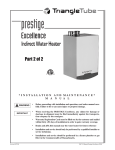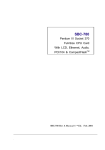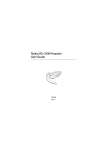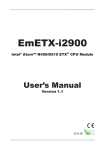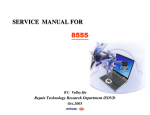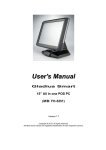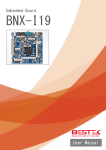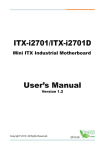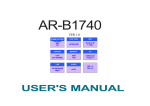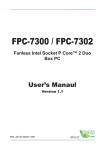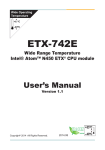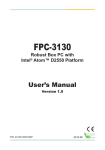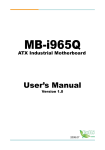Download Rigid-310/311
Transcript
Rigid-310/311 Extreme Rugged, Intel Atom N270, Fanless Embedded Controller User’s Manual Version 1.0 P/N: 4016031000100P 2010.03 This page is intentionally left blank. Index Contents Copyright Notice.................................................................i FCC Class A.........................................................................i Important Safety Instructions...........................................ii About User’s Manual........................................................iii Warning..............................................................................iii Technical Support.............................................................iii Warranty............................................................................iv Ordering Information........................................................iv Chapter 1 - Introduction............................................. 1 1.1 1.2 1.3 1.4 1.5 Overview......................................................................2 Packing List.................................................................3 The Installation Paths of CD Driver...........................3 Specifications.............................................................4 Dimensions.................................................................6 Chapter 2 - Installation............................................... 7 2.1 Top View......................................................................8 2.2 Front View ..................................................................9 2.3 Rear View . ................................................................10 2.4 Jumper Settings........................................................11 2.5 Pin Assignments for Connectors............................16 2.6 How to Access CF Card...........................................21 2.7 How to Remove Top Cover......................................23 2.8 How to Install Hard Disk Drive.................................24 2.9 How to Install PCI Express Mini Card.....................28 2.10 Wall Mounting (Optional).......................................31 2.11 VESA Mounting (Optional).....................................32 2.12 DIN Rail Mounting (Optional).................................34 2.12.1 Face-Left/Right DIN Rail Mounting..................35 2.12.2 Face-Up/Down DIN Rail Mounting...................36 2.12.3 Removing the Computer from the DIN Rail....37 -- Index 2.13 Wiring the DC-Input Power Source.......................38 Chapter 3 - BIOS....................................................... 39 3.1 BIOS Introduction.....................................................40 3.2 BIOS Setup................................................................41 3.3 Standard CMOS Features........................................42 3.4 Advanced BIOS Features.........................................44 3.5 Advanced Chipset Features.....................................46 3.6 Integrated Peripherals..............................................47 3.7 Power Management Setup.......................................52 3.8 PnP/PCI Configurations...........................................53 3.9 PC Health Status.......................................................54 3.10 Load Optimized Defaults . .....................................55 3.11 Set Password .........................................................56 3.12 Save & Exit Setup...................................................57 3.13 Exit Without Saving................................................57 Chapter 4 - Appendix............................................... 59 4.1 Watchdog Timer (WDT) Setting...............................60 - II - Copyright Notice All Rights Reserved. The information in this document is subject to change without prior notice in order to improve the reliability, design and function. It does not represent a commitment on the part of the manufacturer. Under no circumstances will the manufacturer be liable for any direct, indirect, special, incidental, or consequential damages arising from the use or inability to use the product or documentation, even if advised of the possibility of such damages. This document contains proprietary information protected by copyright. All rights are reserved. No part of this document may be reproduced by any mechanical, electronic, or other means in any form without prior written permission of the manufacturer. FCC Class A This equipment has been tested and found to comply with limits for a Class A digital device, pursuant to Part 15 of the FCC rules. These limits are designed to provide reasonable protection against harmful interference installations. This equipment generates, uses and can radiate radio frequency energy, and if not installed and used in accordance with the instructions, may cause harmful interference to radio communications. However, there is no guarantee that interference will not occur in a particular installation. If this equipment does cause interference to radio or television equipment reception, which can be determined by turning the equipment off and on, the user is encouraged to try to correct the interference by one or more of the following measures: • • • • Reorient or relocate the receiving antenna Move the equipment away from the receiver Plug the equipment into an outlet on a circuit different from that to which the receiver is connected Consult the dealer or an experienced radio/television technician for additional suggestions You are cautioned that any change or modifications to the equipment not expressly approved by the party responsible for compliance could void Your authority to operate such equipment. -- Important Safety Instructions Read these safety instructions carefully 1. Read all cautions and warnings on the equipment. 2. Place this equipment on a reliable surface when installing. Dropping it or letting it fall may cause damage 3. Make sure the correct voltage is connected to the equipment. 4. For pluggable equipment, the socket outlet should be near the equipment and should be easily accessible. 5. Keep this equipment away from humidity. 6. Disconnect this equipment from the A/C outlet before cleaning it. Use a moist cloth. Do not use liquid or sprayed detergent for cleaning. 7. The openings on the enclosure are for air convection and protect the equipment from overheating. DO NOT COVER THE OPENINGS. 8. Position the power cord so that people cannot step on it. Do not place anything over the power cord. 9. If the equipment will not be used for a long time, disconnect it from the power source to avoid damage by transient overvoltage. 10. Never pour any liquid into opening. This may cause fire or electrical shock. 11. Never open the equipment. For safety reasons, the equipment should be opened only by qualified service personnel. 12. If one of the following situations arises, get the equipment checked by service personnel: a. The power cord or plug is damaged. b. Liquid has penetrated into the equipment. c. The equipment has been exposed to moisture. d. The equipment does not work well, or you cannot get it to work according to the user's manual. e. The equipment has been dropped or damaged. f. The equipment has obvious signs of breakage. 13. The sound pressure level at the operator's position, according to IEC 704-1:1982, is no more than 70dB(A). 14. Keep this User’s Manual for later reference. - ii - About User’s Manual This User’s Manual is intended for experienced users and integrators with hardware knowledge of personal computers. If you are not sure about any description in this User’s Manual, please consult your vendor before further handling. Warning The computer and its components contain very delicate Integrated Circuits (IC). To protect the computer and its components against damage caused by static electricity, you should always follow the precautions below when handling it: 1. Disconnect your computer from the power source when you want to work on the inside. 2. Use a grounded wrist strap when handling computer components. 3. Place components on a grounded antistatic pad or on the bag that came with the computer, whenever components are separated from the system. Technical Support If you have any technical difficulties, please consult the user’s manual first at: ftp://ftp.arbor.com.tw/pub/manual Please do not hesitate to call or e-mail our customer service when you still cannot find out the answer. http://www.arbor.com.tw E-mail:[email protected] - iii - Warranty This product is warranted to be in good working order for a period of one year from the date of purchase. Should this product fail to be in good working order at any time during this period, we will, at our option, replace or repair it at no additional charge except as set forth in the following terms. This warranty does not apply to products damaged by misuse, modifications, accident or disaster. Vendor assumes no liability for any damages, lost profits, lost savings or any other incidental or consequential damage resulting from the use, misuse of, or inability to use this product. Vendor will not be liable for any claim made by any other related party. Vendors disclaim all other warranties, either expressed or implied, including but not limited to implied warranties of merchantibility and fitness for a particular purpose, with respect to the hardware, the accompanying product’s manual(s) and written materials, and any accompanying hardware. This limited warranty gives you specific legal rights. Return authorization must be obtained from the vendor before returned merchandise will be accepted. Authorization can be obtained by calling or faxing the vendor and requesting a Return Merchandise Authorization (RMA) number. Returned goods should always be accompanied by a clear problem description. Ordering Information Item Description Rigid-310 Barebone system w/o storage device Rigid-311 Barebone system w/o storage device DRK-001 DIN rail kit of FPC series VMK-3100 FPC-3100 VESA-mount kit SSD-25080 Intel® 2.5" 80GB SATAII SSD kit - iv - Introduction 1 Chapter 1 Introduction Chapter 1 - Introduction -- Introduction 1.1 Overview The Rigid-310/311 Embedded Controller is targeted at many different application fields. By adopting it, you can pinpoint specific markets, such as Thin Client, KIOSK, information booth, GSM Server, environment-critical and space-critical applications. • • • • • • • Compact-sized Slim and compact chassis (less than 1U high) is designed to meet space-critical applications. Modular Design The modular design facilitates maintenance or possible upgrades. Modular Embedded Controller can be easily modified to fit many different applications according to customers' requests. Powerful Communication Capability The Rigid-310/311 serial ports, adapted for RJ-45 connectors, can be easily connected via the ordinary UTP cables. Besides, it also provides Gigabit Ethernet, USB, VGA and DVI/LVDS connectors. VGA & DVI/LVDS Rigid-310/311 supports 3D rendering video performance and dual video outputs (analog & digital). Advanced Storage Solution Rigid-310/311 comes with an outside accessible CompactFlash slot, which offers a better, faster and more cost-effective expansibilities for various applications. Trustworthy The onboard Watchdog Timer can invoke an NMI or system RESET when your application loses control over the system. Windows OS Support ARBOR offers platform support for Windows CE 5.0, Windows CE 6.0, Windows XP, Windows XPe, Ubuntu and DOS. -- Introduction 1.2 Packing List After opening the package, carefully inspect the contents. If any of the items is missing or appears damaged, please contact with your local dealer or distributor. The package should contain the following items: Standard: • • • • • • 1 x Rigid-310 or Rigid-311 Embedded Controller 1 x Accessory kit (Driver CD/User’s Manual/Screws/Terminal Block) AC/DC adapter kit Wall-mount kit COM coverter cable (1*RJ-45 to 1*DB-9) L=195mm LVDS kit Options: The following items are normally optional, but some vendors may include them as a standard package, or some vendors may not to carry all the items. • • VESA-mount kit DIN rail kit 1.3 The Installation Paths of CD Driver Windows 2000 & XP Driver Path CHIPSET \Chipset\Intel\Inf 8.3 VGA \Graphics\Intel_2K_XP_32\1432 AUDIO \Audio\realtek_HD\windows_R209 LAN \Ethernet\realtek\8111B_win5698 -- Introduction 1.4 Specifications MainBoard Processor Soldered onboard Intel Atom N270 1.6GHz FSB 533MHz BIOS Phoenix-Award PnP Flash BIOS Chipset Intel 945GSE + Intel ICH7-M Graphics Chipset Intel GMA950 integrated; supports up to 2048 x 1536 (QXGA) resolution System Memory Soldered onboard 1GB DDR2-533 SDRAM Serial ATA 1 x SATA 150MB/s Expansion Bus 1 x Mini-card slot Ethernet Controller 2 x Realtek RTL8111C PCIe Gigabit Ethernet Watchdog Timer 1 ~ 255 level Reset I/O Port Serial Port (RJ-45 connector) 1 x RS-232 2 x RS-232/422/485 USB Port 6 x USB 2.0 LAN Port 2 x RJ-45 1 x DB-15 female connector 1 x DVI-D female connector (Rigid-310 only) Video Audio 1 x LVDS connector supporting dual channels 24-bit LVDS output (Rigid-311 only) Rigid-310 Mic/Line-in/Line-out (6W pre-amplified) Rigid-311 Mic-in/Line-out Storage HDD/SSD 1 x 2.5" drive bay for HDD or SSD CF 1 x CompactFlash slot (outside accessible) Safety FCC Class A certificated CE Certificated -- Introduction Environment Operating Temp. -40 ~ 70ºC (-40 ~ 158ºF), ambience w/ airflow Storage Temp. -40 ~ 85ºC (-40 ~ 185ºF) Relative Humidity 10 ~ 95% @ 40oC (non-condensing) Vibration 3 grms/5 ~ 500 Hz/random operation Operating 20G (11ms), Non-operating 60G w/ HDD Shock & Crash Operating 40G (11ms), Non-operating 80G w/ CF/SSD Crash 100G (11ms) Mechanical Construction Aluminum alloy Mounting Wall-mount, VESA-mount & DIN rail mounting Weight 1.89kg (4.16lb) (barebone) Dimensions (W x D x H) 252 x 199 x 33 mm (9.92" x 7.83" x 1.29") Power Requirement Power Input DC 10 ~ 28V Power Consumption 25 Watt (Max.) -- Introduction 1.5 Dimensions Dimension (W x D x H): 252 x 199 x 33 mm (9.92" x 7.83" x 1.29") Unit: mm 199.00 33.00 Rigid-310 252.00 199.00 33.00 Rigid-311 252.00 -- Unit: mm Installation 2 Chapter 2 Installation Chapter 2 - Installation -- Installation 2.1 Top View -- Installation 2.2 Front View -- Installation 2.3 Rear View - 10 - Installation 2.4 Jumper Settings Clearing CMOS Placing the jumper on pin 2-3 allows users to reset the CMOS to default values. Please carefully follow the steps below to avoid damaging the mainboard. 1. Disconnect the power supply by either turning off the power button on the front panel or simply pulling the power cord out of the AC power socket. 2. Set the jumper to “Pin 2-3 closed.” 3. Wait for five seconds. 4. Set the jumper to “Pin 1-2 closed.” 5. Power on the computer. Pin 1-2 closed: (default) Normal Operation. - 11 - Pin 2-3 closed: Clear CMOS data. Installation JPWR1: AT/ATX Power Mode Selection Connector type: 2.54 mm pitch 1x2-pin header JPWR1 1 2 2 1 1 Pin Voltage 1 1 1 1 1 2 1 1 1 1 2 1 1 1 2 AT mode 1 2 ATX Mode (Default) 1 2 1 1 1-2 1 2 1 1 1 1 21 1 1 1 1 1 1 Note: Users can set the power mode via this header or the BIOS setup utility. Please refer to the BIOS setup utility chapter for Integrated Peripherals >>> SuperIO Device >>> POWERON After PWR-Fail section. 1 JRS3~4: RS-232/422/485 Mode Selection for COM2/COM3 The COM2 and COM3 ports can be configured to operate in standards of RS-232, RS-422 or RS-485. RS422/RS-485 modes differ in the way RX/TX is being handled. Please use jumpers JRS3 and JRS4 to switch between modes for COM2 & COM3 respectively. 1 21 1 1 1 1 1 1 1 1 2 1 1 1 1 2 1 1 1 2 1 1 1 1 JRS3 1 1 1 JRS4 RS-232 (Default) RS-422 RS-485 1-2 ON OFF OFF 3-4 OFF ON OFF 5-6 OFF OFF 1 2 1 5 6 5 - 12 - 1 2 1 1 1 Connector type: 2.00mm pitch 2x3-pin header Mode 1 2 2 1 1 1 ON 2 1 2 6 5 6 Installation J6: Selection of Pin-1 Signal to COM1 The signal of pin-1 to COM1 could be defined as DSR or RI by setting jumper J6. 1 2 2 1 1 1 2 1 1 1 1 21 1 1 1 1 1 1 1 1 1 2 1 1 1 1 2 1 1 2 1 1 1 2 1 1 1 1 Connector type: 2.00 mm pitch 1x3-pin header Pin Voltage 1-2 Set to DSR (Default) 1 2 3 1 2 3 1 2-3 Set to RI J6 1 JTM3: RS-422/485 Terminator Connector type: 2.00 mm pitch 2x4-pin header COM2 RS-485 RS-422 COM3 RS-485 1 1 1 1 2 1 2 1 1 1 1 1 1 1 Terminator RS-422 21 1 1 1 1 1 1 2 1 1 Pin 1 2 2 1 1 1 1 1 2 8 1 7 2 8 1 7 2 8 1 7 2 8 1 7 - 13 - 1 JTM3 1 Installation J2, J3: COM2 Port RS-232/422/485 Output Selection The table below describes the pin definition of pin-1, pin-2, pin-7 and pin-8 to COM2 by setting jumpers J2 & J3. 1 2 2 1 1 1 1 1 1 21 1 1 1 1 1 1 2 1 1-3 3-5 Pin-1 is set to TX+ 2-4 Pin-2 is set to DCD (Default) 4-6 Pin-2 is set to TX- J3 Pin-7 is set to CTS (Default) 3-5 Pin-7 is set to RX+ 2-4 Pin-8 is set to RTS (Default) 4-6 Pin-8 is set to RX- 1 1 1 1 2 6 1 5 2 6 1 5 2 6 1 5 2 6 1 5 2 6 1 5 2 6 1 5 2 6 1 5 2 6 1 5 Description 1-3 1 2 1 2 1 Description Pin-1 is set to DSR (Default) 1 1 1 Connector type: 2.00 mm pitch 2x3-pin header J2 1 2 1 1 1 - 14 - J2 J3 1 1 1 1 1 1 1 1 1 1 Installation J4, J5: COM3 Port RS-232/422/485 Output Selection The table below describes the pin definition of pin-1, pin-2, pin-7 and pin-8 to COM3 by setting jumpers J4 & J5. 1 2 2 1 1 1 1 1 1 21 1 1 1 1 1 1 2 1 1-3 3-5 Pin-1 is set to TX+ 2-4 Pin-2 is set to DCD (Default) 4-6 Pin-2 is set to TX- J5 Pin-7 is set to CTS (Default) 3-5 Pin-7 is set to RX+ 2-4 Pin-8 is set to RTS (Default) 4-6 Pin-8 is set to RX- 1 1 1 1 2 6 1 5 2 6 1 5 2 6 1 5 2 6 1 5 2 6 1 5 2 6 1 5 2 6 1 5 2 6 1 5 Description 1-3 1 2 1 2 1 Description Pin-1 is set to DSR (Default) 1 1 1 Connector type: 2.00 mm pitch 2x3-pin header J4 1 2 1 1 1 - 15 - J4 J5 1 1 1 1 1 1 1 1 1 1 Installation 2.5 Pin Assignments for Connectors SATA1 ~ 2 On-board Serial ATA connector Pin Description 1 GND 2 TX+ 3 TX- 4 GND 5 RX- 6 RX+ 7 GND 1 1 USB Ports USB 2.0 type A connector Pin Description 1 VCC5 2 Data- 3 Data+ 4 GND 1 2 3 4 LAN Ports RJ-45 connector Pin Description 1 BI_DA+ 2 BI_DA- 3 BI_DB+ 4 BI_DB- 5 BI_DC+ 6 BI_DC- 7 BI_DD+ 8 BI_DD- 8 - 16 - 1 Installation COM1~3: Serial Port Connectors Connector type: RJ-45 connector Pin COM1 COM2 COM3 1 DSR/RI DSR/TX+ DSR/TX+ 2 DCD DCD/TX- DCD/TX- 3 DTR DTR DTR 4 GND GND GND 5 RXD RXD RXD 6 TXD TXD TXD 7 CTS CTS/RX+ CTS/RX+ 8 RTS RTS/RX- RTS/RX- 8 1 COM1 8 1 COM2 8 1 COM3 Note: Please locate the setting headers on the motherboard to configure the COM1 ~ COM3 ports. 1. The signal of pin 1 to COM1 can be defined by setting jumper J6. 2. The signals of pin 1, 2, 7 and 8 to COM2/COM3 can be defined by setting J2, J3, J4 and J5 respectively. - 17 - Installation DVI-D Connector Connector type: DVI-D female. 1 8 17 24 DVI-D Pin Description Pin Description Pin Description 1 TMDS Data 2- 9 TMDS Data 1- 17 TMDS Data 0- 2 TMDS Data 2+ 10 TMDS Data 1+ 18 TMDS Data 0+ 3 TMDS Data 2/4 shield 11 TMDS Data 1/3 shield 19 TMDS Data 0/5 shield 4 TMDS Data 4- 12 TMDS Data 3- 20 TMDS Data 5- 5 TMDS Data 4+ 13 TMDS Data 3+ 21 TMDS Data 5+ 6 DDC clock 14 +5V 22 TMDS Data clock shield 7 DDC data 15 GND 23 TMDS clock+ 8 Analog vertical sync 16 Hot plug detect 24 TMDS clock- - 18 - Installation LVDS Connector Connector type: 36-pin LVDS female connector Pin Description Pin Description 1 LCD_VCC 19 LCD_VCC 2 TX1CLK 20 TX2CLK 3 TX1CLK# 21 TX2CLK# 4 GND 22 GND 5 TX1OUT0 23 TX2OUT0 6 TX1OUT#0 24 TX2OUT#0 7 GND 25 GND 8 TX1OUT1 26 TX2OUT1 9 TX1OUT#1 27 TX2OUT#1 10 GND 28 GND 11 TX1OUT2 29 TX2OUT2 12 TX1OUT#2 30 TX2OUT#2 13 GND 31 GND 14 TX1OUT3 32 TX2OUT3 15 TX1OUT#3 33 TX2OUT#3 16 GND 34 GND 17 ENVBR 35 ENABKL 18 +12V 36 +12V - 19 - Installation VGA Connector Connector type: Three-row/15-pin VGA Connector 5 1 15 11 Pin Description Pin Description Pin Description 1 RED 6 GND 11 N/C 2 GREEN 7 GND 12 VDDAT 3 BLUE 8 GND 13 HSYNC 4 N/C 9 N/C 14 VSYNC 5 GND 10 GND 15 VDCLK Audio Jacks Line-out Line-in Mic-in Power Input Terminal Block Receptacle Rigid-310/311 comes with a 2-pin receptacle for the terminal block wired to the DC power source. 10 - 28V + - DC IN - 20 - Installation 2.6 How to Access CF Card 1. Make sure you have turned off the power before inserting or ejecting the CF card. 2. Locate the CF card door on the front panel. 3. Use a crosshead screwdriver (#1 tip) to remove the screw anticlockwise that secures the CF card door. Pull down the door. 4. Insert your CF card into the slot until it stays firmly in place. When it is done, the card ejection button pops up. - 21 - Installation 5. After inserting the CF card, close the card door and screw it on clockwise. 6. To remove the CF card, follow steps 1, 2 and 3 above. And then press the ejection button inwards to pop up the CF card. - 22 - Installation 2.7 How to Remove Top Cover 1. Locate the 4 screws which secure the top cover. 2. Use screwdriver to remove the top cover screws. 3. Slightly take the top cover off the unit upward. - 23 - Installation 2.8 How to Install Hard Disk Drive 1. Locate the 4 screws on the HDD Holder Bracket. 2. Remove the screws and keep them safely for later use. 3. Take the bracket off the HDD bay. 4. Put the HDD into the HDD holder bracket and screw it on. screw holes for fixing HDD screw holes for fixing HDD - 24 - Installation 3. Attach the SATA power and control cables as shown below. 4. Put the HDD with holder bracket assembled back to the HDD bay and screw it on. - 25 - Installation 5. Connect the other end of the SATA power cables to the SATA power connector on the motherboard. 6. Connect the other end of the SATA control cable to the lower SATA connector on the motherboard. - 26 - Installation 7. Having finished the steps above, please arrange the cables as shown below before you put the top cover back. - 27 - Installation 2.9 How to Install PCI Express Mini Card This section is intended for guiding users through the PCI Express Mini Card installation. Please take the following, installing a wireless PCI Express Mini card, as an example. 1. See the figures below. Locate the PCI Express Mini Card socket. 2. Obliquely align the wireless card with the socket and press it into the socket till the gold-colored contacts are fully inserted. 3. Pivot the card down and secure it with the screws. - 28 - Installation 4. The next is to install the attena stick. Push the plastic cap that covers the antenna opening out of the unit. Plastic Cap 5. Remove the left-side cover of the unit by unscrewing the screws that secure the front panel, rear panel and the bottom cover. - 29 - Installation 6. After removing the left-side cover, insert the threaded connector of the antenna cable through the antenna opening and secure it with the accompanying nut. Connect the other end of the cable to any one of the contacts on the wireless card. Securing Nut Threaded Connector Wiring Contacts 7. Having installed the wireless kit, assemble the whole unit and screw clockwise the antenna stick onto the connector. - 30 - Installation 2.10 Wall Mounting (Optional) Prepare the wall-mount bracket and a screwdriver for wall mounting. Follow the instructions below: 1. Place the computer upside down on a flat surface and locate the 4 rubber foot screws. 2. Unscrew them and separate the screws from the rubber feet. Keep the rubber feet for desktop installation. 3. Use the screws to secure the wall-mount bracket to the unit. 4. When the bracket is attached, the computer is now able to be hanged on the wall. - 31 - Installation 2.11 VESA Mounting (Optional) Rigid-310/311 can be mounted to the rear side of the LCD monitor that is VESA 75/100 compliant. To mount Rigid-310/311 to your monitor, please prepare the wall-mount bracket, VESA-mount brackets, accompanying screws and a screwdriver and follow the instructions as below: 1. Locate the VESA compliant screw holes at the rear of the LCD monitor. 2. Secure the VESA mounting brackets firmly to the monitor. - 32 - Installation 3. With the wall-mount bracket attached, slide Rigid-310/311 onto the VESA bracket. When the computer is well seated, secure it to the VESA bracket with the accompanying screws. See the figures shown below. - 33 - Installation 2.12 DIN Rail Mounting (Optional) Prepare the DIN rail kit and a screwdriver for DIN rail mounting. Follow the instructions below: 1. Place the computer upside down on a flat surface and locate the 4 rubber foot screws. 2. Unscrew them and separate the screws from the rubber feet. Keep the rubber feet for desktop installation. 3. As the figure shown below, align the screw holes of the DIN rail bracket with the ones of the main unit. Use the screwdriver to secure the bracket to the main unit with the accompanying screws. 4. You can mount the computer on a DIN rail in the horizontal or vertical direction. 5. Fasten a pair of DIN rail clips to the DIN rail bracket which was attached to the main unit. Please refer to the following figures for horizontal and vertical orientation mounting. - 34 - Installation 2.12.1 Face-Left/Right DIN Rail Mounting 1. For panel face-left/right mounting, please secure the two DIN rail clips to the DIN rail bracket according to the illustration. 2. Position the bracket side of the computer directly in front of the DIN rail. Make sure the DIN rail spring is hooked over the top of the DIN rail. If the computer can’t be fixed firmly, rotate the unit and hook the clip’s spring to the bottom of the DIN rail. Embedded Controller mounted on the DIN rail - 35 - Installation 2.12.2 Face-Up/Down DIN Rail Mounting 1. For panel face-up/down mounting, please secure the two DIN rail clips to the DIN rail bracket according to the illustration. 2. Position the bracket side of the computer directly in front of the DIN rail. Make sure the DIN rail spring is hooked over the top of the DIN rail. If the computer can’t be fixed firmly, rotate the unit and hook the clip’s spring to the bottom of the DIN rail. Embedded Controller mounted on the DIN rail - 36 - Installation 2.12.3 Removing the Computer from the DIN Rail 1. Make sure that power is removed from the computer, and disconnect all cables from the computer. 2. Hold the computer in both hands and push downwards. As the clip releases, lift the bottom of computer slightly. - 37 - Installation 2.13 Wiring the DC-Input Power Source Warning Only trained and qualified personnel should be allowed to install or replace this equipment. Follow the instructions below for connecting the computer to a DC-input power source. 1. Before wiring, make sure the power source is disconnected. 2. Locate the terminal block that shipped in the accessory box with your computer. 3. Using the wire-stripping tool, strip a short piece of insulation from the output wires of the DC power source. The wire guage must be in the range between 14-22 AWG. 4. Identify the positive and negative feed positions for the terminal block connection. See the symbols printed on the rear panel indicating the polarities and DC-input power range in voltages. 5. Insert the exposed wires into the terminal block plugs. Only wires with insulation should extend from the terminal block plugs. Note that the polarities between the wires and the terminal block plugs must be positive to positive and negative to negative. 6. Use a slotted screwdriver to tighten the captive screws. Plug the terminal block firmly, which wired, into the receptacle on the rear panel. Terminal Block + - + - 38 - - BIOS 3 Chapter 3 BIOS Chapter 3 - BIOS - 39 - BIOS 3.1 BIOS Introduction This motherboard provides a programmable EEPROM to which you can update the BIOS utility. The BIOS (Basic Input/Output System) is a program that deals with the basic level of communication between processor and peripherals. Use the BIOS Setup program only when installing motherboard, reconfiguring system, or prompted to "Run Setup". This chapter explains the Setup Utility of BIOS utility. NOTE: In order to increase system stability and performance, our engineering staff are constantly improving the BIOS menu. The BIOS setup screens and descriptions illustrated in this manual are for your reference only, may not completely match what you see on your screen. - 40 - BIOS 3.2 BIOS Setup Phoenix - AwardBIOS CMOS Setup Utility ►Standard CMOS Features ►PC Health Status ►Advanced BIOS Features Load Optimized Defaults ►Advanced Chipset Features Set User Password ►Integrated Peripherals Save & Exit Setup ►Power Management Setup Exit Without Saving ►PnP/PCI Configurations Esc: Quit F9: Menu in BIOS ↑↓→←: Select Item F10: Save & Exit Setup Time, Date, Hard Disk Type... The Award BIOS provides a Setup utility program for specifying the system configurations and settings. The BIOS ROM of the system stores the Setup utility. When you turn on the computer, the Award BIOS is immediately activated. Pressing the <Del> key immediately allows you to enter the Setup utility. If you a little bit late press the <Del> key, POST (Power On Self Test) will continue with its test routines, thus preventing you from invoking the Setup. If you still wish to enter Setup, restart the system by pressing the “Reset” button or simultaneously pressing the <Ctrl>, <Alt> and <Delete> keys. You can also restart by turning the system Off and back On again. The following message will appear on the screen: Press <DEL> to Enter Setup In general, you press the arrow keys to highlight items, <Enter> to select, the <PgUp> and <PgDn> keys to change entries, <F1> for help and <Esc> to quit. When you enter the Setup utility, the Main Menu screen will appear on the screen. The Main Menu allows you to select from various setup functions and exit choices. - 41 - BIOS 3.3 Standard CMOS Features “Standard CMOS Features” allows you to record some basic hardware configurations in your computer system and set the system clock and error handling. If the CPU card is already installed in a working system, you will not need to select this option. You will need to run the Standard CMOS option, however, if you change your system hardware configurations, such as onboard battery fails, or the configuration stored in the CMOS memory was lost or damaged. Phoenix - AwardBIOS CMOS Setup Utility Standard CMOS Features Date (mm:dd:yy) Mon, Apr 13 2009 Time (hh:mm:ss) 11 : 50 : 0 Item Help Menu Level ►IDE Channel 0 Master [ None] ►IDE Channel 0 Slave [ None] ►IDE Channel 2 Master [ None] ►IDE Channel 2 Slave [ None] Video [EGA/VGA] Halt On [No Errors] Base Memory 640K Extended Memory 1038336K Total Memory 1039360K ↑↓→←:Move Enter:Select F5: Previous Values Date ► Change the day, month, year and century The date format is: +/-/PU/PD:Value F10:Save F6: Fail-Safe Defaults ESC:Exit F1:General Help F7: Optimized Defaults Day : Sun to Sat Month : 1 to 12 Date : 1 to 31 Year : 1999 to 2099 Time The time format is: Hour : 00 to 23 Minute : 00 to 59 Second : 00 to 59 To set the date & time, highlight the “Date” & “Time” and use the <PgUp>/ <PgDn> or +/- keys to set the current time. - 42 - BIOS IDE Channel 0 Master/ Slave & Channel 2 Master/Slave The onboard PCI IDE connectors provide Primary and Secondary channels for connecting up to four IDE hard disks or other IDE devices. Each channel can support up to two hard disks; the first is the “Master” and the second is the “Slave”. Press <Enter> to configure the hard disk. The selections include Auto, Manual, and None. Select ‘Manual’ to define the drive information manually. You will be asked to enter the following items. Cylinder: Number of cylinders Head: Number of read/write heads Precomp: Write precompensation Landing Zone: Landing zone Sector: Number of sectors The Access Mode selections are as follows: CHS (HD < 528MB) LBA (HD > 528MB and supports Logical Block Addressing) Large (for MS-DOS only) Auto Video This field selects the type of video display card installed in your system. You can choose the following video display cards: EGA/VGA For EGA, VGA, SEGA, SVGA or PGA monitor adapters. (default) CGA 40 Power up in 40 column mode. CGA 80 Power up in 80 column mode. MONO For Hercules or MDA adapters. Halt On This field determines whether or not the system will halt if an error is detected during power up. All errors Whenever the BIOS detects a non-fatal error, the system will stop and you will be prompted. No errors (default) The system boot will not be halted for any error that may be detected. All, But Keyboard The system boot will not be halted for a keyboard error; it will stop for all other errors. All, But Diskette The system boot will not be halted for a disk error; it will stop for all other errors. All, But Disk/Key The system boot will not be halted for a keyboard or disk error; it will stop for all others. - 43 - BIOS 3.4 Advanced BIOS Features Phoenix - AwardBIOS CMOS Setup Utility Standard CMOS Features ►Hard Disk Boot Priority [ Press Enter ] Hyper-Threading Technology [Enabled] Quick Power On Self Test [Enabled] First Boot Device [Har Disk] Second Boot Device [CDROM] Boot Other Device [Enabled] Boot Up NumLock Status [On] Security Option [Setup] x APIC mode ↑↓→←:Move Item Help Menu Level ► Select Hard Disk Boot Device Priority Enabled Enter:Select F5: Previous Values +/-/PU/PD:Value F10:Save F6: Fail-Safe Defaults ESC:Exit F1:General Help F7: Optimized Defaults Hard Disk Boot Priority It allows you to set the priority for hard disk boot. When you press enter, the selections shows the current hard disks used in your system as well as the “Bootable Add-in Card” that is relevant to other boot sources media such as SCSI cards and LAN cards. Hyper-Threading Technology If enabled, when your processor supports Hyper-Threading Technology. Setting: Disabled, Enabled (Default). Quick Power On Self Test When enabled, it speeds up the Power On Self Test (POST) after the system is turned on. If it is set to Enabled, BIOS will skip some items. Setting: Disabled, Enabled (Default). - 44 - BIOS First/Second Boot Device These fields determine the drive that the system searches first for an operating system. Setting: Hard Disk, CDROM, USB-FDD, USB-ZIP, USB-CDROM, LAN and Disabled. Boot Other Device It allows the system to search for an OS from other devices other than the ones selected in the First/Second Boot Device. Setting: Disabled, Enabled (Default). Boot Up NumLock Status It allows you to activate the NumLock function after you power up the system. Setting: Off, On (Default). Security Option It allows you to limit access to the System and Setup. When you select System, the system prompts for the User Password every time you boot up. When you select Setup, the system always boots up and prompts for the Supervisor Password only when the Setup utility is called up. Setting: Setup (Default), System. APIC Mode APIC stands for Advanced Programmable Interrupt Controller. This setting is always enabled. - 45 - BIOS 3.5 Advanced Chipset Features Phoenix - AwardBIOS CMOS Setup Utility Advanced Chipset Features On-Chip Frame Buffer Size [ 8MB 8MB] DVMT Mode [ DVMT] DVMT/FIXED Memory Size [ 128MB] Boot Display [ CRT+SDVO LVDS] SDVO Panel Number [ 1024x768 (18) ] ↑↓→←:Move +/-/PU/PD:Value Enter:Select F5: Previous Values Item Help Menu Level F10:Save F6: Fail-Safe Defaults ESC:Exit ► F1:General Help F7: Optimized Defaults On-Chip Frame Buffer Size Setting: 1MB, 8MB (Default). DVMT Mode Setting: FIXED, DVMT (Default), BOTH. DVMT/FIXED Memory Size Setting: 64MB, 128MB (Default), 224MB. Boot Display Rigid-310 Setting: CRT, DVI, CRT+DVI (default) Rigid-311 Setting: CRT, LCD, CRT+LCD, SDVO LVDS, CRT+SDVO LVDS (default) SDVO Panel Number This item allows users to select the LCD Panel type (FPC-3101 only). Setting: 800 x 600 (18), 1024 x 768 (18), 1024 x 768 (24), 1280 x 1024 (24D) Default: 1024 x 768 (24) - 46 - BIOS 3.6 Integrated Peripherals Phoenix - AwardBIOS CMOS Setup Utility Integrated Peripherals ►On-Chip IDE Device [ Press Enter ] ►SuperIO Device [ Press Enter] ►USB Device Setting [ Press Enter] Azalia Audio [ Azalia] Onboard Lan Boot ROM [ Disabled] ↑↓→←:Move +/-/PU/PD:Value Enter:Select F5: Previous Values Item Help Menu Level F10:Save F6: Fail-Safe Defaults ESC:Exit ► F1:General Help F7: Optimized Defaults OnChip IDE Device >>> Phoenix - AwardBIOS CMOS Setup Utility OnChip IDE Device IDE HDD Block Mode [ Enabled ] On-Chip Primary [ Enabled] PCI IDE Item Help IDE Primary Master PIO [ Auto] IDE Primary Slave PIO [ Auto] IDE Primary Master UDMA [ Auto] IDE Primary Slave UDMA [ Auto] On-Chip Serial ATA [ Enhanced Mode] ↑↓→←:Move +/-/PU/PD:Value Enter:Select F5: Previous Values Menu Level F10:Save F6: Fail-Safe Defaults ESC:Exit ► F1:General Help F7: Optimized Defaults IDE HDD Block Mode It allows HDD controller to use the fast block mode to transfer data to and from HDD. Setting: Disabled, Enabled (Default). On-Chip Primary PCI IDE The integrated peripheral controller contains an IDE interface with support for two IDE channels. Select Enabled to activate each channel separately. Setting: Disabled, Enabled (Default). - 47 - BIOS IDE Primary Master/Slave PIO It allows your system HDD controller to run faster. Rather than having the BIOS issue with a series of commands that transferring to or from the disk drive, PIO (Programmed Input/Output) allows the BIOS to communicate with the controller and CPU directly. When Auto is selected, the BIOS will select the best available mode. Setting: Auto (Default), Mode 0, Mode 1, Mode 2, Mode 3, Mode 4. IDE Primary Master/Slave UDMA It allows your system to improve disk I/O throughput to 33MB/sec with the Ultra DMA33 feature. Setting: Disabled, Auto. On-Chip Serial ATA Setting:Disabled Auto Disabled SATA controller Auto arrange by BIOS. Combined Mode PATA and SATA are combined. Max.of 2 IDE drives in each channel. Enhanced Mode Enable both SATA and PATA. Max. of 6 (Default)IDE drivers are supported. SATA Only SATA is operating in legacy mode. - 48 - BIOS SuperIO Device >>> Phoenix - AwardBIOS CMOS Setup Utility SuperIO Device Serial Port 1 [ 2E8 ] Serial Port 1 Use IRQ [ IRQ4] Serial Port 2 [ 4F8] Serial Port 2 Use IRQ [IRQ5] Serial Port 3 [ 4E8] Serial Port 3 Use IRQ [IRQ10] PWRON After PWR-Fail [ Off] ↑↓→←:Move +/-/PU/PD:Value Enter:Select F5: Previous Values Item Help Menu Level F10:Save F6: Fail-Safe Defaults ESC:Exit ► F1:General Help F7: Optimized Defaults Onboard Serial Port & IRQ It allows you to select the onboard serial and parallel ports with their addresses. Setting: Serial Port 1 2E8/IRQ4 (Default) Serial Port 2 4F8/IRQ5 (Default) Serial Port 3 4E8/IRQ10 (Default) PWRON After PWR-Fail It allows users to set the computer to automatically start itself up after a power failure. With the option set to On, the computer will start itself up when power is restored. If the option is set to Off, the computer will remain powered off even when power is restored. With the Former-Sts option selected, whether the computer will start itself up or not depends on its previous status. Setting: Off (Default), On, Former-Sts. - 49 - BIOS USB Device Setting>>> Phoenix - AwardBIOS CMOS Setup Utility USB Device Setting USB 1.0 Controller [ Enabled ] USB 2.0 Controller [ Enabled] USB Operation Mode [ High Speed] USB Keyboard Function [ Enabled] USB Storage Function [ Enabled] Item Help Menu Level ► *** USB Mass Storage Device Boot Setting *** ↑↓→←:Move Enter:Select +/-/PU/PD:Value F5: Previous Values F10:Save F6: Fail-Safe Defaults ESC:Exit F1:General Help F7: Optimized Defaults USB Controller Setting: Enabled (Default), Disabled. USB 2.0 Controller For using USB 2.0, it is necessary OS drivers must be installed first. Please update your system to at least Windows 2000 SP4 or Windows XP SP2. Setting: Enabled (Default), Disabled. USB Operation Mode This setting determines the USB device operation mode. Setting: High Speed (Default), Full/Low Speed. USB Keyboard Function This setting allows you to enable/disable the USB keyboard support. Setting: Enabled (Default), Disabled. USB Storage Function This setting allows you to enable/disable the USB storage support. Setting: Enabled (Default), Disabled. - 50 - BIOS Azalia Audio This setting allows you to enable/disable the Azalia Audio support. Setting: Azalia (Default), Disabled. Onboard Lan Boot ROM This setting allows you to enable/disable the Onboard Lan Boot ROM. Setting: Disabled (Default), Enabled. - 51 - BIOS 3.7 Power Management Setup Phoenix - AwardBIOS CMOS Setup Utility Power Management Setup ACPI Function [ Enabled ] PCI Express PME [ Disabled] Soft-Off by PWR-BTTN [ Instant-Off] Wake-Up by PCI card [ Disabled] Item Help Menu Level ► *** USB Mass Storage Device Boot Setting *** ↑↓→←:Move Enter:Select +/-/PU/PD:Value F5: Previous Values F10:Save F6: Fail-Safe Defaults ESC:Exit F1:General Help F7: Optimized Defaults ACPI Function It supports ACPI (Advanced Configuration and Power Interface). Setting: Enabled (Default), Disabled. PCI Express PME Enable or disable the PCI Express PME function. Setting: Disabled (Default), Enabled. Soft-Off by PWR-BTTN It defines the power-off mode when using an ATX power supply. In the Instant Off mode, It allows powering off immediately upon pressing the power button. In the Delay 4 Sec mode, the system powers off when the power button is pressed for more than 4 seconds or enters the suspend mode when pressed for less than 4 seconds. Setting: Instant-off (Default), Delay 4 Sec. . Wake-Up by PCI card When enabled, a PME signal from PCI card returns the system to Full On state. Setting: Disabled (Default), Enabled. - 52 - BIOS 3.8 PnP/PCI Configurations Phoenix - AwardBIOS CMOS Setup Utility PnP/PCI Configurations Reset Configuration Data [ Disabled ] Resources Controlled By [ Auto (ESCD)] x IRQ Resources Press Enter ↑↓→←:Move Enter:Select F5: Previous Values +/-/PU/PD:Value Item Help Menu Level F10:Save F6: Fail-Safe Defaults ESC:Exit ► F1:General Help F7: Optimized Defaults Reset Configuration Data It allows you to determine whether to reset the configuration data or not. Setting: Disabled (Default), Enabled. Resources Controlled By This PnP BIOS can configure all of the boot and compatible devices with the use of a PnP operating system. Setting: Auto(ESCD) (Default), Manual. - 53 - BIOS 3.9 PC Health Status Phoenix - AwardBIOS CMOS Setup Utility PC Health Status Current System Temp. 49ºC/120ºF Current CPU Temperature 57ºC/134ºF CPU VCore 0.89 V 1.5V 1.55 V VCC3 3.34 V 5V 5.08 V VBAT 3.13 V ↑↓→←:Move Enter:Select F5: Previous Values +/-/PU/PD:Value Item Help Menu Level F10:Save F6: Fail-Safe Defaults ESC:Exit Current System Temperature This field displays the current system temperature. Current CPU Temperature This field displays the current temperature of CPU. CPU Vcore/1.5V/VCC3/+5V/VBAT Detect the system’s voltage status automatically. - 54 - F1:General Help F7: Optimized Defaults ► BIOS 3.10 Load Optimized Defaults Phoenix - AwardBIOS CMOS Setup Utility ►Standard CMOS Features ►PC Health Status ►Advanced BIOS Features Load Optimized Defaults ►Advanced Chipset Features Set User Password ►Integrated Peripherals Save & Exit Setup ►Power Management Setup ►PnP/PCI Configurations Esc: Quit F9: Menu in BIOS Exit Without Saving Load Optimized Defaults (Y/N)? N ↑↓→←: Select Item F10: Save & Exit Setup Load Optimized Defaults It allows you to load the default values to your system configuration. The default setting is optimal and enables all high performance features. Type <Y> and press <Enter> to load the optimized default values. Or type <N> to return to Setup utility. - 55 - BIOS 3.11 Set Password Phoenix - AwardBIOS CMOS Setup Utility ►Standard CMOS Features ►PC Health Status ►Advanced BIOS Features Load Optimized Defaults ►Advanced Chipset Features Set User Password ►Integrated Peripherals Save & Exit Setup ►Power Management Setup Enter Password: Exit Without Saving ►PnP/PCI Configurations Esc: Quit F9: Menu in BIOS ↑↓→←: Select Item F10: Save & Exit Setup Change/Set/Disable Password This item allows users to set a password that will be used exclusively on the system. To specify a password, highlight the item and press <Enter>. As soon as you press <Enter>, a message box shows up to prompt users to type password. Type the password, up to eight characters in length, and press <Enter>. And the system confirms your password by asking you to type it again. After setting a password, the screen automatically returns to the main screen. To disable a password, just leave the box blank and press <Enter> when you are prompted to enter the password. A message will confirm the password to be disabled. Once the password is disabled, the system will boot, then you can enter BIOS Setup freely. - 56 - BIOS 3.12 Save & Exit Setup Phoenix - AwardBIOS CMOS Setup Utility ►Standard CMOS Features ►PC Health Status ►Advanced BIOS Features Load Optimized Defaults ►Advanced Chipset Features Set User Password ►Integrated Peripherals Save & Exit Setup ►Power Management Setup Exit Without Saving ►PnP/PCI Configurations Esc: Quit Save to CMOS and EXIT (Y/N)? Y F9: Menu in BIOS ↑↓→←: Select Item F10: Save & Exit Setup Save Data to CMOS Type <Y> and press the <Enter> key to quit the setup utility and save all the changes into the CMOS memory. Or type <N> to return to Setup utility. 3.13 Exit Without Saving Phoenix - AwardBIOS CMOS Setup Utility ►Standard CMOS Features ►PC Health Status ►Advanced BIOS Features Load Optimized Defaults ►Advanced Chipset Features Set User Password ►Integrated Peripherals Exit Without Saving Save & Exit Setup ►Power Management Setup ►PnP/PCI Configurations Esc: Quit Quit Without Saving (Y/N)? F9: Menu in BIOS ↑↓→←: Select Item F10: Save & Exit Setup Abandon all Data Type <Y> and press the <Enter> key to quit the Setup utility without saving the modifications. Or type <N> to return to Setup utility. - 57 - BIOS This page is intentionally left blank. - 58 - Appendix 4 Chapter 4 Appendix Chapter 4 - Appendix - 59 - Appendix 4.1 Watchdog Timer (WDT) Setting WDT is widely applied to industry computers to monitor activities of CPU. The programmed application triggers WDT with adequate timer setting depending on its requirement. Before WDT counts down to zero, the functional system will reset the counter. In case the WDT counter is not reset by an abnormal system, it will counts down to zero and then reset the system automatically. This computer supports watchdog timer up to 255 levels for software programming. Below is the source code written in assembly & C, please take them for WDT application examples. Source Code in Assembly Language ============================ ;-- Initial W83627hf - mov AX, 2Eh mov DX, AX mov AL, 87h out DX, AX ; out DX, AX ; initial W83627HF start ;-- mov AX, 2Eh mov DX, AX mov AL, 2Bh out DX, AL ; Select CR2B mov AL, 00h inc DX out DX, AL ; Set CR2B bit 4=0, PIN89=WDTO ;-- mov AX, 2Eh mov DX, AX mov AL, 07h out DX, AL ; Point to Logical Device Selector mov AL, 08h inc DX out DX, AL ; Select Logical Device 8 ;-- - 60 - Appendix ;-- ;-- ;-- ;-- ;-- end mov mov mov out mov inc out AX, 2Eh DX, AX AL, 30h DX, AL ; select CR30 AL, 01h DX DX, AL ; update CR30 to 01h mov mov mov out mov inc out AX, 2Eh DX, AX AL, 0F0h DX, AL ; select CRF0 AL, 00h DX DX, AL ; set CRF0=00h, output mov mov mov out mov inc out AX, 2Eh DX, AX AL, 0F5h DX, AL ; select CRF5, WDT Timer unit AL, 00h ; bit2 =0 ->second ; bit2 =1 -> minute DX DX, AL ; update CRF5 bit2 to 00h mov mov mov out mov inc out AX, 2Eh DX, AX AL, 0F6h DX, AL ; select CRF6, WDT Timer AL, 05h DX DX, AL ; update CRF6 to 5 unit mov mov mov out AX, 2Eh DX, AX AL, AAh DX, AX - 61 - Appendix Source Code in C Language ====================== /*-----Include Header Area -----*/ #include "math.h" #include "stdio.h" #include "dos.h" /*----- routing, sub-routing -----*/ void main() { outportb(0x2e, 0x87); outportb(0x2e, 0x87); /* initial IO port twice */ outportb(0x2e, 0x2B); outportb(0x2e+1, 0x00); /* select CR2B */ /* update CR2B bit4 to 00h */ /* Set PIN89 as WDTO */ outportb(0x2e, 0x07); outportb(0x2e+1, 0x08); outportb(0x2e, 0x30); outportb(0x2e+1, 0x01); outportb(0x2e, 0xf0); outportb(0x2e+1, 0x00); outportb(0x2e, 0xf5); outportb(0x2e+1, 0x00); outportb(0x2e, 0xF6); outportb(0x2e+1, 0x05); /* point to logical device selector */ /* select logical device 8 */ /* select CR30 */ /* update CR30 to 01h */ /* select CRF0 */ /* update CRF0 to 00h */ /* select CRF5 to set timer unit */ /* update CRF5 bit2, 0:sec; 1:Min. */ /* select CRF6 */ /* update CRF6 to 05h (5 sec) */ outportb(0x2e, 0xAA); /* stop program W83627HF, Exit */ } - 62 -







































































